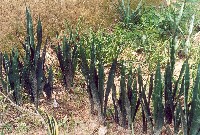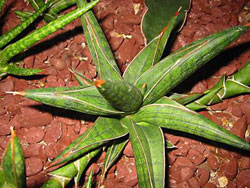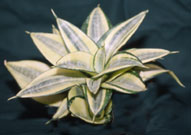Cultivation of Sansevierias
Sansevierias are succulent plants and so need a well-drained compost and moderate watering. In the summer months they can be watered frequently and appreciate this, as long as the soil does not remain water-logged, but in the cooler months they are best left dry. A minimum winter temperature of 10°C is recommended. Short periods of lower temperatures may however be tolerated as long as the plants are dry.
Sansevierias will grow in many positions but appreciate good light and dappled sun to grow naturally and produce good leaf shape and colouration. Long green leaves, often produced in low light situations, and admired my some collectors and growers, are not normal and the leaves tend to be weak and featureless.
The soil used for Sansevierias can be adapted to suit whatever materials are available locally. The main constituent needs to be a material which anchors the plant in the ground but at the same time keeps the compost open to allow for excess water to drain through quickly. This could be pumice or lava or any other neutral material. To this needs to be added in about equal proportions some kind of material containing humus and fertilizer. Again almost anything will be suitable, peat or coir based composts or even orchid composts with a slow release fertilizer added.
Sansevierias are difficult to keep in captivity as they always try to escape! Most spread through underground rhizomes. These are very strong and can split a plastic pot or shatter a ceramic one! Many species also send new shoots down vertically. In open ground these go so far and then turn upwards ensuring the new growth is not too close to the mother plant when it emerges from the soil. In a pot of course this habit has the effect of pushing the whole plant and soil out of the pot! The only solution is to repot into something deeper to allow the shoot to reach bottom and turn back upwards. Once the new growth has emerged and produced leaves it can be removed and potted separately if so desired. Potting in hanging baskets is another way to facilitate off-setting.
Propagation is by division as described above. Most plants can also be propagated from leaf cuttings, but not the variegated forms. Plants can also be produced from seed although this is a slow process.



